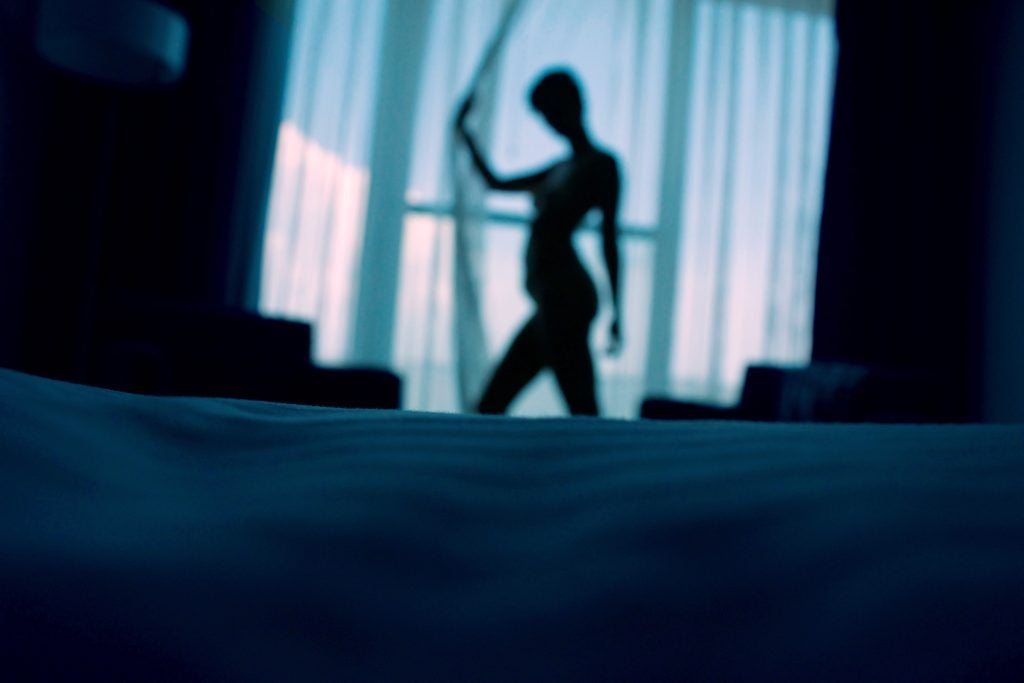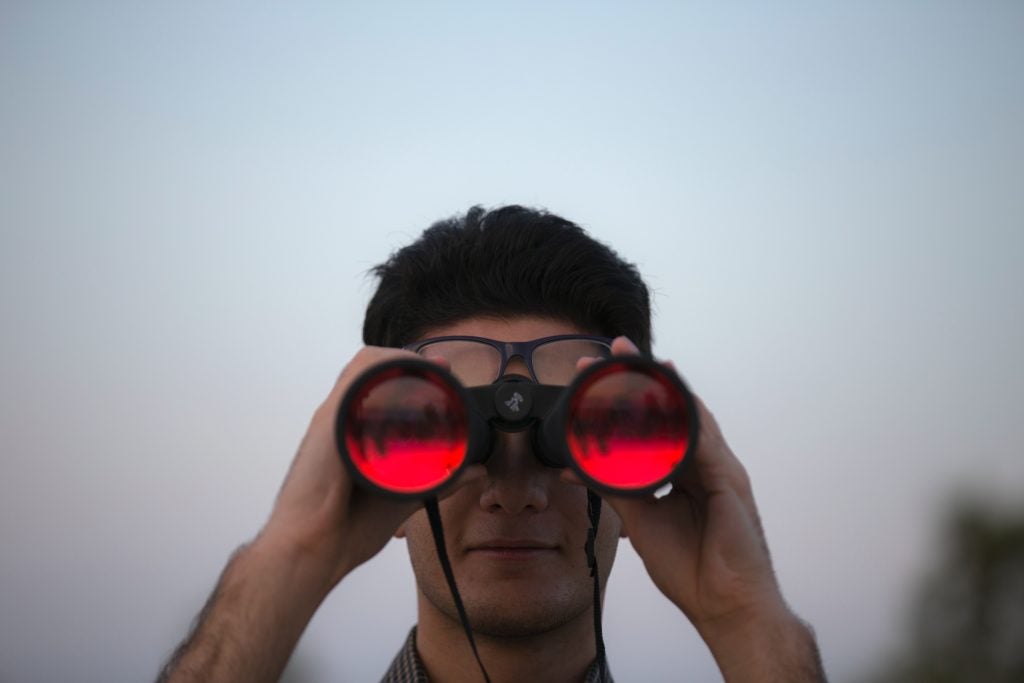
Voyeurism, or voyeuristic disorder, is a paraphilia in which a person derives sexual pleasure from the act or fantasy of watching unsuspecting people while they are undressing, bathing, participating in sexual acts, or engaging in other private activities. Voyeurs are also commonly known as “Peeping Toms” or simply, “peepers.” Males are more likely to engage in voyeuristic behaviors than females.1 Some examples of voyeuristic activity include spying on people who are taking showers, looking through binoculars at people undressing in front of windows, or watching people from hidden locations. Other more modern examples of voyeuristic behaviors include using cell phone cameras to look up women’s skirts and paying to spy on people over the internet. The risk of getting caught by the victim often leads to greater sexual excitement for the voyeur. Voyeurs often masturbate during or after watching someone, as a way of increasing their sexual pleasure. For an individual to be diagnosed with a voyeuristic disorder, they must prefer the sexual pleasure associated with watching someone over normal sexual activity, such as sexual contact with a partner.¹
Table of Contents
Symptoms
To be diagnosed with a voyeuristic disorder, a number of criteria must be met. First, the individual must be eighteen years of age or older and experiencing voyeuristic tendencies for six months or more. Second, the individual must experience strong, persistent sexual arousal from the fantasy or act of observing an unsuspecting person who is fully or partially naked, involved in sexual acts, having a highly erotic conversation, or—in rare cases—urinating or defecating. Finally, the person being observed must be non-consenting, and the paraphilic act must be causing significant distress or impairment to the social, professional, and daily functioning of the actor.2
Causes
There is no proven cause for the voyeuristic disorder. Because voyeuristic urges are naturally present in many people, some theorize that voyeuristic disorder may be triggered by an accidental sighting of someone who is undressing, naked, participating in sexual activity, or performing another private act. This sighting may set off a pattern of continued viewing, which eventually leads to voyeuristic disorder.2
Some studies suggest that voyeuristic disorder may be more common in those who also have other paraphilic disorders, depression, bipolar disorder, anxiety disorders, conduct disorder, antisocial personality disorder, and/or identify as hypersexual.3
Treatment
The best way to treat voyeuristic disorder is early prevention and redirection of desire. From a young age, all people should be taught socially appropriate behaviors, such as respecting others’ right to privacy and basic ideas of consent. Those who feel they have voyeuristic tendencies can attempt to redirect their urges to consensual acts, such as watching pornography that depicts voyeuristic situations but is performed by consenting adults. Additionally, seeking out the advice and guidance of a qualified and supportive therapist can be very helpful in discussing ways to redirect voyeuristic desires before acting on them.
After voyeuristic disorder has been professionally-diagnosed, treatments such as psychotherapy, support groups, and medication can be helpful. Therapy can provide voyeurs with helpful tools to stop voyeuristic actions, such as learning how to redirect thoughts and fantasies to more socially appropriate behaviors. Group therapy can offer individuals suffering from voyeuristic disorder the chance to gain support from others who identify as voyeurs, and mentorship from those who have successfully overcome their voyeuristic behaviors. There is currently no medication that specifically treats voyeurism, but voyeurs in the criminal justice system are often given anti-androgenic drugs and/or selective serotonin reuptake inhibitors (SSRIs) to suppress sex drive, therefore decreasing the desire for voyeuristic behavior.2 The most important step to overcoming voyeuristic disorder is a desire on the part of the voyeur to overcome their voyeuristic behaviors.
Is Voyeurism Normal?

Many people experience voyeuristic tendencies, such as fantasizing about what other people may look like naked or becoming sexually aroused at the sight of another naked person. According to one study, about half of adolescent males have participated in an act that would be considered voyeuristic.1 Some scholars consider reality television programs, such as Survivor and Big Brother, to be voyeuristic by nature; these shows often have “hidden” cameras around set that film every move of the show’s participants. Additionally, viewing pornography–a very common act–can be considered voyeuristic, because it involves a person gaining sexual pleasure by viewing nudity or sexual acts performed by others.4 To some people, these examples shift the definition of “voyeurism” from a deviant behavior to a guilty pleasure enjoyed by many. The difference, however, between voyeurism and viewing reality television shows or pornography is that participants of television shows and legal pornographic content have knowingly agreed to be filmed, photographed, and viewed by others.
While voyeuristic behavior is normal and quite common, peeping and voyeuristic observation become atypical when a person repeatedly seeks or resorts to peeping for sexual pleasure and eroticizes voyeuristic experiences by masturbating. Voyeurism is considered a coercive paraphilia because the unsuspecting victim has not consented to being viewed by others.1
Is Voyeurism Legal?
The legality and criminal punishment of voyeurism vary depending on where the activity takes place. The severity of punishment can depend on whether or not photos and/or videos were taken of the victim, and whether or not this content was then published without consent. In the United States, voyeurism is handled on a state-by-state basis. There are at least twelve states with laws specifically outlawing voyeurism: Alaska, Delaware, Georgia, Indiana, Louisiana, Mississippi, North Carolina, Ohio, South Dakota, Tennessee, Virginia, and Washington.5 How voyeurism is defined differs depending on the state. For example, in Alaska, a person must be found guilty of viewing or producing a photo of the genitals, anus, or female breasts of another person for the crime to be considered voyeurism. In North Carolina, the law outlines explicitly that only females can be victims of voyeurism. In most states where voyeurism is illegal, the act is classified as a misdemeanor and is punishable by sixty days to five years of imprisonment, and five-hundred to three-thousand dollars in fines.5
In India, the Indian Penal Code (IPC) now recognizes voyeurism, defined as watching a woman engaging in a private act while she has no reasonable expectation to be observed, as a crime punishable by three or more years in jail and/or a fine between two and five lakh rupees (between $3,000 and $8,000). There are separate laws resulting in additional sentencing and fines depending on whether or not the voyeur also videotaped and/or photographed the unsuspecting individual.6 In Japan, the act of voyeurism in the form of “up-skirt” photography has become a widespread problem. “Up-skirt” photography is the act of taking a photo up the skirt or dress of a woman, usually in a crowded place such as a subway car, without her knowledge or consent. In some prefectures, such as the Kyoto prefecture, this action is illegal and punishable by fines and prison time.7 The “up-skirt” photo problem is so pervasive that all cellphones manufactured and sold in Japan have a mandatory shutter sound that cannot be turned off when taking a photo or video, even if the phone is set to “silent.”8
Even in places where voyeurism is not explicitly illegal, one can find themselves in trouble with the law for voyeuristic behavior. Invasion of privacy, disorderly conduct, breach of peace, trespassing, and harm to reputation are all legal bases that can be used to prosecute acts of voyeurism in places where there is no specific law against it.5,9 Aside from this, the act of voyeurism is considered to be morally corrupt and can lead to social stigmatism and isolation, even if one never faces legal repercussions.
Victims of Voyeurism
There are many different opinions on the harm voyeuristic behaviors cause their victims. Some people feel that because most victims of voyeurism will never know they were being observed, these cases can be seen as a “harmless” act. Others, however, argue that whether or not the victim is aware makes no difference: voyeurism is always wrong. At the end of the day, victims themselves are the only ones who can speak to the effects of voyeurism on their psychological well-being and everyday life. Many victims of voyeurism find themselves deeply affected by the incident, and end up changing their daily routine, wearing different clothing, and doing more activities in the dark so they cannot be viewed or photographed as easily. There are support groups, both online and in-person, where victims of voyeurism can come together to discuss their trauma, experiences, and offer encouragement. One proactive step individuals can take to protect against voyeurism is to keep curtains drawn and doors shut whenever one is operating in private and does not wish to be seen. Additionally, keeping a sticker or piece of paper over computer webcams when they are not in use is an easy way to prevent online voyeurism.
Concluding Remarks

While the voyeuristic disorder is fairly rare, voyeuristic desires and tendencies are experienced by many people throughout their lives. Feeling sexually aroused at the thought or sight of seeing another person undressing, participating in a sexual act, or engaging in other private behaviors is not an uncommon sensation; however, this does not mean that acting on voyeuristic desires is morally or legally acceptable. Voyeurism violates the privacy of the person being observed and ignores their right to consensual participation. For those who feel aroused by voyeuristic urges, there are ways to redirect these urges; for those who are worried about becoming a victim of voyeurism or who have been a victim in the past, simple preventative measures can help grant peace of mind and a sense of protection against voyeurism. Voyeurism is not something to fear, but something that can be effectively controlled and managed by both the actors and receivers of voyeuristic acts.
References
- LeVay, Simon, Janice I. Baldwin, and John D. Baldwin. Discovering Human Sexuality. 2nd ed. Sunderland, MA: Sinauer Associates, 2012. Print.
- “Voyeuristic Disorder.” Psychology Today, Sussex Publishers, 10 Oct. 2017.
- Patricelli, Kathryn. “Voyeuristic Disorder.” Sexual Disorders, Scioto Paint Valley Mental Health Center.
- Metzl, Jonathan M. “Voyeur Nation? Changing Definitions of Voyeurism, 1950-2004.” Harvard Review of Psychiatry (Taylor & Francis Ltd), vol. 12, no. 2, Mar/Apr2004, pp. 127-131.
- Norman-Eady, Sandra. “Voyeurism.” OLR Research Report, 14 Oct. 2003.
- Das, Atin Kumar. “Law relating to Electronic voyeurism in India: Eyes behind the mirror.” International Journal of Law, vol. 3, no. 3, May 2017, pp. 154–157.
- Johnston, Eric. “Kyoto law puts ‘upskirt’ photography in focus.” The Japan Times, 25 May 2014.
- Smith, Mat. “Japan’s noisy iPhone problem.” Engadget, Oath Tech Network AOL Tech, 30 Sept. 2016.
- “The Sex Crime of Voyeurism.” Hg.org, Hg.org Legal Resources.
Last Updated: 13 February 2018.
